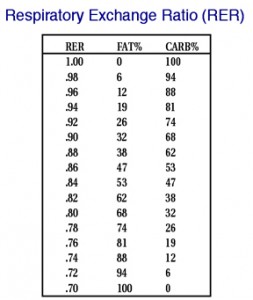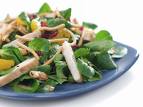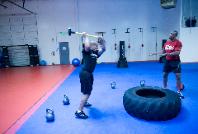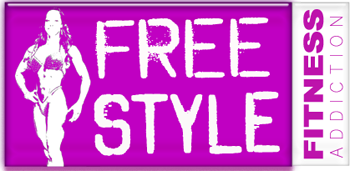Endless waves upon waves of good-intentioned fat-loss seekers tie up their running shoes and walk around their neighborhoods, flock to the gym and trod on their cardio equipment of choice, only eat twice a day, and never get their heart rate above their “fat burning zone.” Yet their jeans remain too snug, the zipper gets harder to close, and women and men grow steadily frustrated with how infrequently they eat, how much cardio they do in their low-heart-rate, “fat burning zone,” yet still fail to lose weight.—->What’s the deal?!
…I’ve re-read “The Science of Fat Loss” by Alwyn Cosgrove (only one of the most sought-after fat loss specialists in the industry) and it was a truly invigorating read. I feel passionate about fat loss, and feel compelled to relay and comment on some of his most salient principles for fat loss success…
HOW YOU BURN CALORIES
First of all, let’s talk about energy expenditure. In a day, you may burn, say, 2000 calories. That is contributed in a small way from factors such as the thermic effect of food, lifestyle (e.g. how much do you move in your job? How sedentary or active are you?), and exercise (e.g. 60 min spin class, half hour lifting weights, etc.). The majority of the calories you burn in a day, however, come from how much muscle mass you carry. Your resting metabolic rate is DIRECTLY related to how much muscle you have. Therefore, someone with a lower body fat percentage will automatically be burning more calories at rest than someone at the same weight with a higher body fat percentage. Do you want to burn fat? Then you want to burn calories, right? So will lifting weights make you “bulky”? No! FOOD can make you bulky- EXERCISE can make you LEAN! Muscle is your fat burning machinery. Lift weights to lose fat!

THE FALLACY OF LOW-INTENSITY AEROBIC TRAINING FOR FAT LOSS
Check out, for example:
Geliebter A, Maher MM, Gerace L, Gutin B, Heymsielf SE, Hashim SA.
Effects of strength or aerobic training on body composition, resting metabolic rate, and peak oxygen consumption in obese dieting subjects.
Am J Clin Nutr. 1997 Sep; 66(3): 557-63.
In a comparison where they burned the same amount of calories during the training session, the strength training group lost significantly more fat than the aerobic training group. Furthermore, the aerobic training group lost significantly more lean body mass than the strength training group (clearly a detriment if muscle is your fat burning machinery).
Why is the myth of the fat burning zone so prevalent? Why do so many women and men think that doing steady state low intensity aerobic training is the way to achieve fat loss? (That’s actually the lowest priority in the hierarchy of fat loss, which I will cover a little later in this entry.) If you look at the chart below, you can see how an individual’s respiratory exchange ration (RER) corresponds to the utilization of either fat or carbohydrate as an energy source for fuel. As you can see, an RER of around .70 or .71 (NASM Essentials of Personal Fitness Training) uses a maximal percentage of its fuel from fat. So that’s where we want to work out? But an RER of .7 is achieved when we are at complete rest. Is complete rest the way to burn calories and fat? Not so, my friends. If body fat loss is desired, you must expend as much energy as possible. And that doesn’t come from resting.

THE HIERARCHY OF FAT LOSS
What are the best practices in achieving fat loss?
1. Proper Nutrition
Eat 5+ meals a day. Limit your consumption of sugars and processed foods. Eat plenty of non-starchy vegetables. Drink more water and cut out calorie-containing beverages. Eat lean proteins throughout the day. Save starchy foods for breakfast and/or post workout only.

2. See #1
You cannot out-train a crappy diet.
Remember, the more exceptional the compliance, the more exceptional the results. The better you eat, the better your results.
3. Activities that burn calories, maintain/promote muscle mass, and elevate metabolism.
- You can do this through metabolic supersets, tri-sets, and circuits. This is characterized by heavy resistance, 8-12 reps (maybe less for more advanced clients or maximal strength goals, and maybe more for deconditioned individuals), 6-8 total body exercises, time under tension of 45-60 seconds (the actual time exposed to the load), and relatively short rest periods (e.g. 15 sec to 1 min). By sequencing the sets with non-competing exercises, it reduces rest needed per body part before you move on to the next exercise, and you are able to do more total work, so you can burn more calories by working ALL your muscles rather than doing a tricep kickback…resting…waiting to recover…doing another set of tricep kickbacks….rest….wait…and again…and maybe again….and then you’re done with your workout and haven’t burned too many calories, and haven’t elevated your metabolism. With metabolic supersets, tri-sets, or circuits, you are initiating EPOC, or Excess Post Exercise Oxygen Consumption. This is the process whereby the metabolic rate recovers to pre-workout levels. This is AWESOME, because it means you are still burning more calories even after your workout!

4. Activities that burn calories and elevate metabolism.
- high intensity anaerobic interval training
- high intensity aerobic interval training

5. Activities that burn calories but don’t necessarily maintain muscle or elevate metabolism.
- steady state high intensity aerobic training
- steady state low intensity aerobic training

CONCLUSIONS
Most importantly, you must have a clean diet. With regards to exercise, resistance training that creates as massive a metabolic disturbance as possible provides you with the most bang for your buck. If you have additional time, go ahead and add some intervals (as hard as you can). If you have even more time, go ahead and bang out some steady state higher intensity cardio. If you have even MORE time to spare, then lastly go ahead and implement some low intensity steady state cardio. The moral of the story is- staying in the “fat burning zone” (e.g. RESTING) is NOT the way to go! Ladies and gents, go out and move with the most vigor you can! Lift heavy weights and WORK! Build your fat-burning machinery- your MUSCLES! The more lean muscle mass you possess, the higher your metabolism will be, and therefore the more fat you will burn! Follow this strictly and expect to see amazing changes in your physique~
MAR

